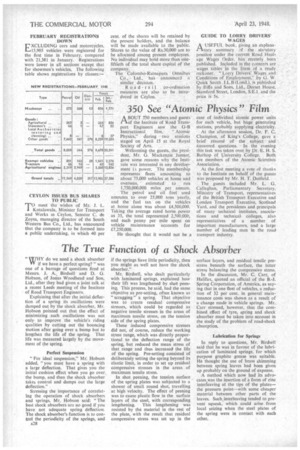The True Function of a Shock Absorber
Page 30

If you've noticed an error in this article please click here to report it so we can fix it.
"WHY do we need a shock absorber VV if we have a perfect spring? " was one of a barrage of questions fired at Messrs. J. A. Birdsell and D. G. Hobson, of Jotias Woodhead and Son, Ltd., after they had given a joint talk at a recent Leeds meeting of the Institute of Road Transport Engineers..
Explaining that after the initial deflection of a spring its oscillations were damped out by the shock absorber, Mr. Hobson pointed out that the effect of minimizing such oscillations was not only to improve the vehicle's riding qualities by cutting out the bouncing motion after going over a bump but to leogthen the life of the spring. That life was measured largely by the movement of the spring.
Perfect Suspension "For ideal suspension," Mr. Hobson added, "you must have a spring with a large deflection. That gives you the initial cushion effect when you go over the bump, and then the shock absorber takes control and damps out the large deflection." .
Stressing the importance of correlating the. operation of shock absorbers and springs, Mr. Hobson said: "The best shock absorbers are no good if you have not adequate spring deflection. The shock absorber's function is to control the periodicity of the springs, and A2& if the springs have little periodicity, then you might as well not have the shock absorber."
Mr. Birdsell, who dealt particularly with laminated springs, explained how their lift was lengthened by shot peening. This process, he said, had the same objective as pre-setting, often known as " scragging" a spring. That objective was to create residual compressive stresses, which could be regarded as negative tensile stresses in the areas of maximum tensile stress, on the tension side of the spring plates.
These induced compressive stresses did not, of course, reduce the working stress range, which was directly proportional to the deflection range of the spring, but reduced the mean stress of that range and thus increased the life of the spring. Pre-setting consisted of deliberately setting the spring beyond its elastic limit, in order to set up residual compressive stresses in the areas of maximum tensile stress.
In shot peening, the tension surface of the spring plates was subjected to a shower of small round shot, travelling at high velocity. The effect of peening was to cause plastic flow in the surface layers of the steel, with corresponding lengthening. This lengthening was resisted by the material in the rest of the plate, with the result that residual compressive stress was set up in the surface layers, and residual tensile prestress beneath the surface, the latter Stress balancing the compressive stress.
In the discussion, Mr. C. Cart-, of Halifax, quoted an official of the B.-J. Spring Corporation, of America, as saying that in one fleet of vehicles, a reduction of 32 per cent, in general maintenance costs was shown as a result of a change made in vehicle springs, Mr.. Carr stressed, however, that the combined effect of tyre, spring and shock absorber must be taken into account in the study of the problem of road-shock absorption.
Lubrication for Springs In reply to questions, Mr. Birdsell said that he was in favour of the lubrication of laminated springs, for which purpose graphite grease was suitable. He thought the use of brass shimming between spring leaves had been given up probably on the ground of expense.
A method which now had its advocates was the insertion of a form of zinc interleaving at the tips of the plates— the pressure point—with some cheaper material between other parts of the leaves. Sucleinterleaving tended to prevent squeak, which could arise from local seizing when the steel plates of the spring were in contact with each other.












































































